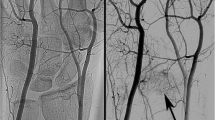Abstract
The periosteal and endosteal blood supply of the human ulna and radius was investigated by anatomical dissection. The main artery concerned is the anterior interosseous artery. It supplies the diaphysis of ulna and radius; its branches feed the distal one-fourths of both the ulna and the radius. The proximal one-fourth of the ulna is supplied by the ulnar artery, the ulnar recurrent artery and the recurrent interosseous artery. Periosteal branches of the common interosseous artery, the ulnar artery and the recurrent interosseous artery supply the proximal one-fourth of the radius. In both bones the main branch of the nutrient artery has an ascending course. The anterior interosseous artery, as the main artery of the periosteal and endosteal supply of the human ulna and radius, is important in transplantation and reconstruction, especially with a view to reducing the rate of pseudarthrosis. When osteosynthesis is planned so-called LC-DC plates should be chosen to preserve the periosteal branches. When a vascularized bone graft is taken from the forearm the vascularization of the remaining bones has to be considered. The vascularity of this area allows various options in grafting.
Zusammenfassung
Ulna und Radius haben ein zusammenhängendes arterielles Versorgungssystem. Das proximale Viertel der Ulna erhält Zuflüsse aus der A. ulnaris, der A. recurrens ulnaris and der A. interossea recurrens. Ihre Diaphyse wird hauptsächlich aus der A. interossea anterior versorgt. Die arterielle Versorgung des distalen Fünftels erfolgt durch Endäste der A. interossea anterior mit Unterstützung durch die A. ulnaris. Die A. nutricia stammt meist aus der A. interossea anterior, tritt oberhalb der Ulnamitte in die Corticalis and zieht nach proximal. Intramedullär hat sie einen aufsteigenden und einen schwächeren absteigenden Ast. Das proximale Radiusviertel wird durch einen R. periostalis versorgt, der zumeist aus der A. interossea communis stammt. Weiterhin wird das proximale Fünftel durch Rr. periostaes aus der A. ulnaris und der A. interossea recurrens versorgt. Die Diaphyse erhält Zuflüsse aus der A. interossea anterior. Das distale Fünftel wird hauptsachlich durch Endäste der A. interossea anterior versorgt, unterstützt durch die A. radialis und die A. ulnaris. Die A. nutricia aus der A. interossea anterior zieht ab knapp 40% der Radiuslänge in der Corticalis nach proximal und hat einen stärkeren aufsteigenden und einen schwächeren absteigenden Ast. Die A. interossea anterior ist das Hauptgefäß für die Versorgung beider Unterarmknochen. Sic gilt es sowohl bei der Transplantation als auch bei der operativen Rekonstruktion zu beachten. Zur Schonung der Rr. periostales sind bei der Osteosynthese sog. LC-DC-Platten empfehlenswert. Beim Heben eines vaskularisierten Knochentransplantates ist auch auf die arterielle Versorgung der verbleibenden Knochenanteile zu achten; gleichwohl sind durch die Angioarchitektur verschiedene Möglichkeiten der Transplantation gegeben.
Similar content being viewed by others
Literatur
Ajmani ML (1982) A study of diaphyscal nutrient foramen in human long bones. Anat Anz 151:305–314
Boorman JG, Brown JA, Sykes PJ (1987) Morbidity in the forearm flap donor arm. Br J Plast Surg 40:207–212
Cormack GC, Duncan MJ, Lamberty BGH (1986) The blood supply of the bone component of the compound osteo-cutaneous radial artery forearm flap — an anatomical study. Br J Plast Surg 39:173–175
Finkbeiner GF (1980) Pseudarthrosen und verzögerte Heilung nach Unterarmbrüchen. Unfallheilkunde 83:353–359
Forriol Campos F, Gomez Pellico L, Gianonatti Alias M, Fernandez-Valencia R (1987) A study of the nutrient foramina in human long bones. Surg Radiol Anat 9:251–255
Friedrich B, Krone JR (1973) Zur Ätiologie von Pseudarthrosen. Unfallheilkunde 76:308–325
Gremigni D, Faveri Tron M de, Faccendi S (1977) La vascolarizzazione arteriosa dell'ulna e del radio nell'Uomo. Arch Ital Anat Embriol 82:179–188
Hierner R, Stock W, Wood MB, Schweiberer L (1992) Der vaskularisierte Fibulatransfer. Unfallchirurg 95:152–159
Lang J, Wachsmuth W (1972) Praktische Anatomie 14, Bein und Statik, 2. Aufl. Springer, Berlin Heidelberg
Lanz T von, Wachsmuth W (1959) Praktische Anatomic 13, Arm, 2. Aufl., Springer, Berlin Heidelberg
Longia GS, Ajmani ML, Saxena SK, Thomas RJ (1980) Study of diaphyseal nutrient foramina in human long bones. Acta Anat (Basel) 107:399–406
Menck, J, Sander A (1992) Periostale und intraossäre Versorgungsstrukturen der Fibula und ihre klinische Bedeutung. Acta Anat (Basel) 145:400–405
Olekas J, Guobys A (1991) Vascularised bone transfer for defects and pseudarthrosis of forearm bone. J Hand Surg [Br] 16:406–408
Pagliei A, Brunelli F, Gilbert A (1991) Anterior interosseus artery: anatomic basis of pedicled bone-grafts. Surg Radiol Anat 13:152–154
Penteado CV, Masquelet AC, Romana MC, Chevrel JP (1990) Periosteal flaps: anatomical bases of sites of elevation. Surg Radiol Anat 12:3–7
Rhinelander FW (1968) The normal microcirculation of diaphyseal corte and its response to fracture. J Bone Joint Surg [Am] 50:784–800
Shulman SS (1959) Observations of the nutrient foramina of the human radius and ulna. Anat Rec 134:685–697
Soutar DS, Scheker LR, Tanner NSB, McGregor IA (1983) The radial forearm flap: a versatile method for intra-oral reconstruction. Br J Plast Surg 36:1–8
Author information
Authors and Affiliations
Additional information
Herrn Professor Dr. W. Lierse in Dankbarkeit gewidmet
Rights and permissions
About this article
Cite this article
Menck, J., Schreiber, H.W., Hertz, T. et al. Angioarchitektur von ulna und radius und ihre praktische relevanz. Langenbecks Arch Chir 379, 70–75 (1994). https://doi.org/10.1007/BF00195866
Received:
Issue Date:
DOI: https://doi.org/10.1007/BF00195866




